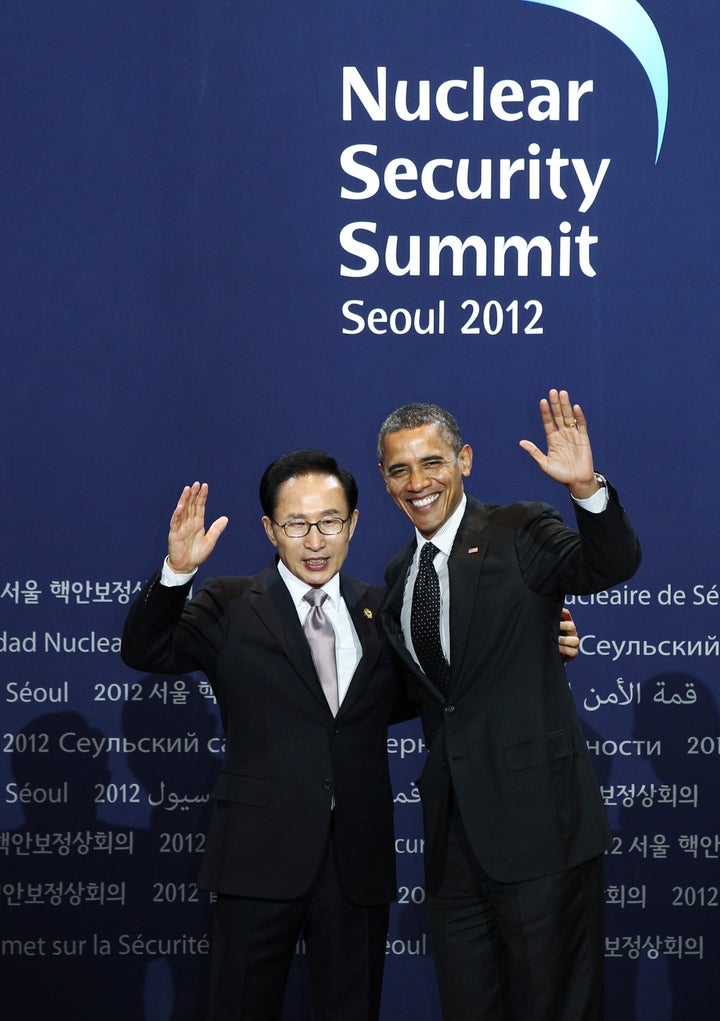
When he first took office, Barack Obama was a leader in the cause of reducing global nuclear arsenals. The president got off to an excellent start four years ago this month when he took the opportunity of a visit to Prague to announce his commitment to promoting "the peace and security of a world without nuclear weapons." He promised to do a number of things to move that agenda forward, from negotiating a new nuclear arms reduction treaty with Russia to taking the lead in locking down or destroying the world's unsecured stocks of nuclear weapons and nuclear bomb-making materials.
The administration got right down to work, beginning negotiations with Russia on a new arms accord -- New START (the Strategic Arms Reduction Treaty). The treaty was signed into law two years ago this month after a tough battle in the Senate which ultimately persuaded 13 Republican senators to support the agreement. This was no mean feat at a time when Republicans in Congress were opposing the administration on virtually every initiative it proposed.
In some respects New START was a modest step forward, cutting deployed nuclear warheads on each side by about one-third, down to 1,550 per side. But the treaty was about more than just numbers. It was the first full-scale arms control treaty between the U.S. and Russia in roughly two decades, and it included a rigorous monitoring system that could not only ensure mutual compliance with New START but also serve as the basis for verifying adherence to any follow-on arms reduction treaties. The most important thing about New START is that it can be a foundation for further progress.
The president moved quickly to jump-start global efforts to secure loose nuclear weapons and poorly protected bomb-making materials, calling an unprecedented summit of 47 world leaders to address the problem. It was the largest gathering of heads of state and government on U.S. soil since the founding conference of the United Nations in 1945. A number of countries took the opportunity of the conference to announce concrete steps like sending their stocks of enriched uranium to the U.S. and Russia for more secure storage and converting reactors into versions whose waste products are much harder to use to develop a nuclear bomb. At the conference, the Obama administration also reiterated its pledge to secure or immobilize all global stocks of nuclear bomb making materials within four years.
A follow-up conference was held in Seoul in 2012. Significant progress has been made since the original summit, including the elimination of all bomb-making materials from 10 countries, but far more needs to be done. The administration's new budget, announced last week, raises questions about whether it can keep up the pace on nuclear security (see more, below).
After getting off to a fast start in its first two years in office, the administration's progress on the nuclear front has slowed considerably. For the moment at least, progress on a new nuclear arms reduction treaty with Russia is blocked by disagreements over the scope and purpose of U.S. missile defense systems in Europe.
The Obama administration has assured Moscow that the emerging system is meant solely as a hedge against the possibility that Iran might develop a nuclear-armed ballistic missile that could reach Europe. But Russian leaders see it as a system that could be adapted to target them, possibly creating the capability for the U.S. to launch a first strike against Russian nuclear sites and then mop up any remaining Russian missiles with its European-based anti-missile system. However remote this prospect may be, Russia is thinking in terms of worst-case scenarios, as military and political leaders so often do.
So, until there is a meeting of the minds on missile defense involving either further assurances to Russia or some form of U.S.-Russian cooperation, the successful negotiation of a new arms reduction treaty is unlikely.
Where does that leave the administration? There are still things that can be done, even absent a new treaty. There have been reports that the administration has been discussing reducing U.S. deployed warheads from the 1,550 level set by New START to perhaps as low as 1,000. This could induce Russia to follow suit even without a formal agreement, or encourage them to resume talks aimed at a new treaty. And whether or not it sparks action by Russia, it will send a positive signal internationally even as it maintains the ability of the U.S. to dissuade any nation from attacking it with a nuclear weapon.
A more ambitious approach would be to embrace the option offered in last year's report by a commission convened by the group Global Zero that calls for the U.S. to go to 900 total warheads over the next decade, down from the current level of over 4,000. The intent of the report was to sketch out a substantial interim step towards eliminating nuclear weapons altogether. The commission was chaired by former head of the U.S. Strategic Command Gen. James Cartwright and included now-secretary of defense Chuck Hagel. Hagel distanced himself from the study's recommendations during his confirmation hearings, stressing that the proposal was "illustrative" and refusing to endorse specific aspects of it. But he certainly understands that we can defend the country with far fewer warheads than exist now.
Another way the administration can set the stage for further progress in nuclear arms reduction is in how it crafts its budget. Unfortunately, the FY2014 budget announced last week was a disappointment in that respect. Not only does it increase the overall nuclear weapons budget of the Department of Energy's National Nuclear Security Administration (NNSA), but it increases spending on unneeded projects like the breathtakingly expensive B-61 bomb while reducing urgently needed nonproliferation funding. The nonproliferation money is targeted at one of the president's key goals, cited above - helping to prevent terrorists from getting their hands on nuclear bombs or bomb-making materials. This job is far from over, so cutting back funding at this point poses an unnecessary risk.
Meanwhile, the B-61 bomb program - which is scheduled to build 400 bombs at a total cost of $10 billion - received a healthy increase of over about $250 million in the FY2014 budget. At $25 million each, the B-61 will literally cost more than its weight in gold. Even worse, it is not needed. Many of the new B-61's are slated for deployment in Europe, where they provide no military advantage and are increasingly unpopular in the countries where they would be deployed.
A logical step in the right direction would be to radically cut back the B-61 program and use some of the resulting funds to shore up nonproliferation projects. The likelihood of this shift happening will depend in part on what the administration hears from the Congress and the public on this issue.
There were some positive elements of the FY2014 nuclear weapons budget. The administration maintained its position of withholding funding for the Chemistry and Metallurgy Research Replacement Facility (CMRR), which was slated to increase the number of plutonium triggers or "pits" for nuclear bombs that can be produced each year. And it slashed spending on the MOX (mixed oxide) plant in South Carolina, which was originally meant to turn plutonium waste from nuclear weapons plants into fuel for civilian reactors. But there are no assured customers for the mixed oxide, and the facility will cost over $20 billion to build and operate over the next two decades. The administration should cancel the MOX project now.
The Obama administration has a lot on its plate at the moment, from North Korea to gun control to immigration to ongoing budget battles with the Congress. But despite these challenges, it can and must vigorously pursue the president's stated goal of eliminating nuclear weapons by finding a way to take additional steps in that direction, even in a tough political environment. It's time to restore the urgency that marked the president's first two years in office. Doing so will make us all safer, and it can also contribute tens of billions of dollars over the next decade towards solving the nation's budget crunch.
